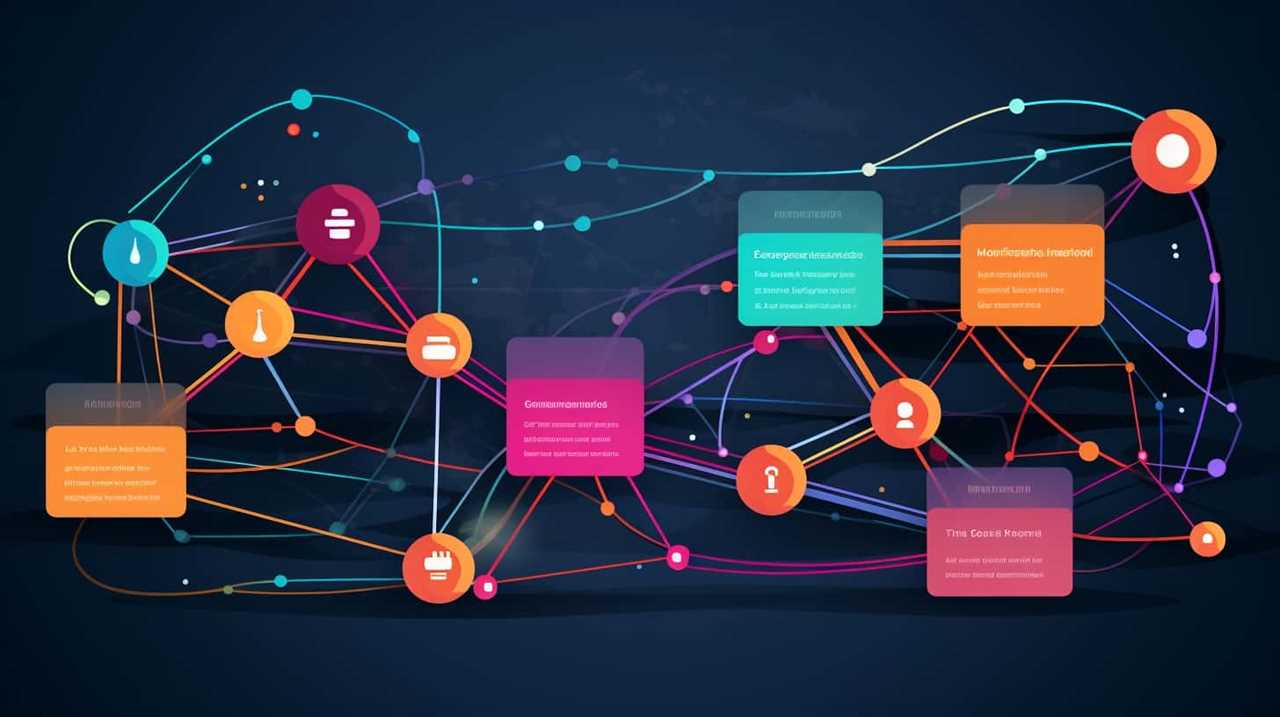Tired of sifting through endless SEO strategies promising to boost your website’s ranking? Look no further! Our definitive guide to mastering the essential elements of SEO has arrived for you.
From on-page optimization to off-page tactics, keyword research to content creation, and technical know-how, we’ve got you covered.
So, sit back, relax, and get ready to take your website to new heights with our foolproof tips and tricks.
Let’s dive in and conquer the world of SEO together!

Key Takeaways
- On-page optimization includes metadata optimization, internal linking strategies, URL optimization, and image optimization to improve search engine visibility and user experience.
- Off-page optimization involves link building, social media marketing, guest blogging, online reputation management, and influencer outreach to increase authority, brand awareness, and visibility.
- Keyword research involves analyzing search volumes, competitor analysis, incorporating long-tail keywords, understanding search intent, and keyword mapping for effective optimization and targeting.
- Content creation and optimization require a well-defined content strategy, SEO-friendly writing techniques, thorough keyword research, high-quality content creation, and optimization of meta tags for improved search engine rankings and user engagement.
- Technical SEO involves optimizing website architecture, server optimization, mobile optimization, site speed optimization, and implementing schema markup for better crawling, indexing, and visibility in search results.
On-page Optimization
In on-page optimization, we focus on optimizing the individual elements of a web page to improve its visibility and rankings in search engine results.
One important aspect of on-page optimization is metadata optimization. This involves optimizing the title tags, meta descriptions, and header tags of a web page to provide search engines with relevant information about the page’s content. By optimizing metadata, we can increase the chances of our web page appearing in search engine results for relevant queries.
Another key element of on-page optimization is internal linking strategies. By strategically linking relevant pages within our website, we can improve the user experience and help search engines understand the structure and hierarchy of our website. These internal links can also help distribute link equity and improve the visibility of our web pages.
Now, let’s move on to the next section about off-page optimization.

Off-page Optimization
Moving from on-page optimization, we’ll now delve into the importance of off-page optimization in improving a website’s visibility and rankings in search engine results. Off-page optimization refers to the actions taken outside of the website itself to improve its online presence.
Here are five key elements of off-page optimization:
- Link building: Creating high-quality, relevant links from other websites to increase authority and credibility.
- Social media marketing: Utilizing social media platforms to promote and share content, engage with audiences, and build brand awareness.
- Guest blogging: Writing and publishing articles on external websites to gain exposure and backlinks.
- Online reputation management: Monitoring and managing the online reputation of a website through reviews, ratings, and customer feedback.
- Influencer outreach: Collaborating with influential individuals or brands to increase visibility and reach a wider audience.
Keyword Research
Continuing from our previous discussion on off-page optimization, let’s now explore the importance of conducting keyword research to improve a website’s search engine visibility and rankings.
Keyword research involves analyzing the terms and phrases that users enter into search engines to find relevant information. By understanding the keywords that are relevant to your business and industry, you can optimize your website’s content to align with those terms, increasing the likelihood of appearing in search results.

Competitor analysis is also a crucial part of keyword research. By analyzing the keywords your competitors are targeting, you can identify opportunities to differentiate yourself and target less competitive long tail keywords.
Long tail keywords are more specific and have lower search volume, but they often have higher conversion rates and can help you attract a more targeted audience. By incorporating competitor analysis and long tail keywords into your keyword research strategy, you can enhance your website’s search engine visibility and ultimately boost its rankings.
Content Creation and Optimization
Let’s delve into the next aspect of SEO, where we further optimize our website through content creation and optimization.
- Content strategy: Developing a well-defined plan for creating and managing content on our website.
- SEO friendly writing techniques: Implementing writing techniques that are optimized for search engines while still providing valuable and engaging content.
- Keyword research: Conducting thorough research to identify relevant keywords and incorporating them strategically in our content.
- High-quality content: Creating content that’s informative, well-written, and relevant to our target audience.
- Optimizing meta tags: Ensuring our meta tags, such as title tags and meta descriptions, accurately reflect the content and include relevant keywords.
When it comes to content creation and optimization, having a solid content strategy is essential. By employing SEO friendly writing techniques, conducting thorough keyword research, creating high-quality content, and optimizing meta tags, we can enhance our website’s visibility and attract organic traffic.

Technical SEO
To optimize our website for search engines, we employ various technical SEO strategies. Two crucial aspects of technical SEO are website architecture and server optimization. Website architecture refers to the structure and organization of a website, which plays a crucial role in how search engines crawl and index it. A well-structured website with clear navigation and hierarchical URLs can improve search engine visibility. Server optimization involves optimizing the technical aspects of a website’s server, such as server response time, caching, and redirects. A fast and reliable server can improve user experience and search engine rankings. By focusing on website architecture and server optimization, we can ensure that our website is technically optimized for search engines and provide a better user experience for our visitors.
| Technical SEO Strategies | Description |
|---|---|
| Website Architecture | Structure and organization of a website, including navigation and URLs. |
| Server Optimization | Optimizing server technical aspects like response time, caching, and redirects. |
Frequently Asked Questions
How Long Does It Take to See Results From SEO Efforts?
When it comes to measuring SEO success and optimizing for local search, one common question is how long it takes to see results from SEO efforts.
It’s important to note that the timeline for seeing results can vary depending on various factors such as the competitiveness of the industry, the level of optimization, and the effectiveness of the strategies implemented.
Generally, it can take several months to start seeing noticeable improvements in search engine rankings and organic traffic.

What Are Some Common Mistakes to Avoid When Optimizing On-Page Elements?
When it comes to on-page SEO, there are some common mistakes that we need to avoid.
One tip is to ensure proper keyword placement in the title tag, URL, and headers.
Another mistake to steer clear of is neglecting to optimize meta descriptions and image alt tags.
Additionally, it’s crucial to avoid keyword stuffing and instead focus on creating high-quality, relevant content.

Can You Provide Examples of Effective Off-Page Optimization Strategies?
Sure!
When it comes to effective off-page optimization strategies, two important factors to consider are link building and social media marketing.
Link building involves acquiring high-quality backlinks from reputable websites, which can improve your website’s authority and visibility in search engine rankings.
Social media marketing, on the other hand, involves promoting your website and content on social media platforms to attract more traffic and engagement.

Both of these strategies are essential for improving your SEO efforts.
How Can I Identify the Right Keywords for My Website?
How can we identify the right keywords for our website?
Are you familiar with keyword research tools and competitor analysis?
These are essential elements to find the most relevant and high-ranking keywords for your website.

By utilizing keyword research tools, we can gather valuable insights into search volumes and competition levels.
Additionally, analyzing our competitors’ keywords can provide us with valuable information on what’s working within our industry.
This comprehensive approach will ensure that our website is optimized for maximum visibility and success.
What Are Some Technical SEO Issues That Can Negatively Impact Website Rankings?
Some technical SEO issues can negatively impact website rankings. Slow website speed can result in a poor user experience and lower search engine rankings. On the other hand, if search engine bots can’t crawl and index your website properly, it won’t rank well in search results.

Therefore, it’s crucial to optimize website speed and ensure easy crawlability to maintain high rankings.
Conclusion
In the world of SEO, it’s crucial to strike a balance between on-page and off-page optimization. Just like a well-coordinated dance, these elements work together to boost your website’s visibility and drive organic traffic.
Keyword research acts as the rhythm, guiding your content creation and optimization efforts.
And just like the technical aspects of a dance routine, technical SEO ensures that your website is running smoothly and efficiently.

By mastering the elements of SEO, you’ll be able to take center stage and captivate your audience.










